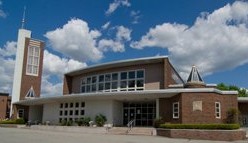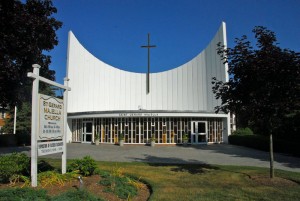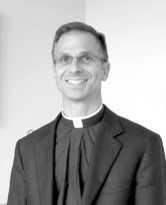Churches to partner up under new pastoral plan
By Jay TurnerAfter more than 50 years of serving different regions of Canton and operating entirely independent of one another, the town’s two Catholic parishes, St. John the Evangelist and St. Gerard Majella, appear to be headed toward a future of collaboration that would involve the sharing of resources, staff, and possibly more — all under the leadership of a single pastor.
The historic restructuring plan, which was unveiled by the Archdiocese of Boston late last year, would affect nearly all of the archdiocese’s 290 parishes as part of a widespread effort to strengthen the church while simultaneously cutting costs.
According to a document prepared by the Archdiocesan Pastoral Planning Commission, the proposed new structure “does not involve changing the parishes themselves; rather, it focuses on the means by which pastoral services are provided in and to our parishes.”
The proposal as currently constituted calls for the creation of roughly 125 “pastoral collaboratives,” consisting primarily of two or three parishes within close proximity to one another. Local examples, in addition to St. John’s and St. Gerard’s, include Immaculate Conception and St. James in Stoughton, St. Bernadette and St. Mary in Randolph, and St. Catherine of Siena and St. Timothy in Norwood. A few larger parishes, such as St. Agatha in Milton, would remain separate.
At the “heart” of the new model, according to the Archdiocese, is a “pastoral service team” (PST) led by a single pastor — most likely chosen from outside of the parishes in question — and a single, representative pastoral council and finance council to service each of the churches within the collaborative. Other staffing decisions, such as whether to employ multiple religious education directors, would be decided by the team according to its local pastoral plan.
In fact, many of the key decisions — including everything from Mass schedules to the possible sale of excess properties such as rectories — are expected to be addressed at the local level by the various PSTs.
“It will be up to each individual team to figure out what they can do to regionalize and make the most out of the benefits of the pastoral service team,” explained Greg Pando, St. Gerard’s current business administrator.
Then again, the proposal is likely to change somewhat as it makes its way through several rounds of consultations with religious and lay leaders before being turned over to Cardinal Sean O’Malley for final approval.
“What I can tell you is that it will be vetted, it will be reviewed, it will be discussed, and at some point in the future it will be revised,” noted Pando, who took part in the most recent consultation that also included priests, deacons, and various lay professionals.
A third round of consultations, involving parish and finance council members, is currently underway and will continue throughout most of March. Individual parishes are then expected to hold a series of open meetings throughout the spring in order to explain the proposal and solicit feedback from parishioners.
The Pastoral Planning Commission has already indicated its plans to adjust the final recommendation based on the feedback it receives. However, the overall vision as laid out by Cardinal O’Malley remains clear: to move as many parishes as possible from “maintenance to mission-based thinking and planning.”
As the commission stated in a recent report, “An alarming number of parishes are simply in survival mode … They cannot grow the church because they are trapped in a vicious cycle of rising costs and flat or falling revenues.”
An estimated 40 percent of parishes within the archdiocese are currently operating at a deficit — and that includes St. Gerard’s, which recently took the controversial step of laying off its longtime music director in an effort to close a projected shortfall of nearly $60,000.
In addition to financial constraints, other “significant challenges” identified by the commission include decreased Mass attendance, fewer men joining the priesthood, fewer people stepping forward to serve professionally in parishes, and the inevitability that pastors will be asked to take on the responsibility of a second or third parish.
At the same time, there seems to be a renewed sense of hope within the archdiocese as a result of the new pastoral plan — even as critics like the Council of Parishes continue to question the sincerity of the church’s efforts.
The locally based Council of Parishes, which has been fighting church closings since a disastrous reconfiguration plan in 2004, is predicting a new round of closings if the new model is approved. And just last week, reports surfaced in the Boston Globe of a scathing letter written by a pastor in West Roxbury who warned that the proposal would demoralize priests and result in “serious psychological and even physical sickness.”
Despite the criticism, leaders within the archdiocese remain undeterred and continue to insist they have the best intentions of the parishes in mind.
“Some in the media have used terms like merger and downsizing, but this proposal includes no closure of parishes and no merging of parishes,” said Father Bryan Parrish, the assistant vicar for administration. “What is being proposed is a change in the way we serve parishes, using economies of scale and trying to work together in a more effective manner.”
A native of Canton who still helps out at St. Gerard’s on weekends, Father Parrish said he could see a scenario in a which a pastoral collaborative decides to sell off an excess rectory or parish center as a way to raise revenue; however, he said such decisions would happen in an “organic way,” adding that there is certainly no intention on the part of the archdiocese to eliminate more parishes.
“I certainly understand that among a number of people there’s a lack of trust,” acknowledged Parrish, “and there’s still some anger over clergy sexual abuse and the reconfiguration back in 2004. It’s understandable that people are suspicious. All we can do is emphasize that it’s a proposal, we’re looking for feedback, and we’re open to alternatives.”
As for how the process will impact a town like Canton, Parrish, like Pando, would not speculate on the specific changes that might occur, yet both men anticipate a smoother transition in suburban communities, where church populations are a bit more stable.
“I don’t see much controversy in terms of a pastoral service team in Canton,” predicted Pando, adding that the idea “makes a lot of sense” for the two local parishes.
Arguably the biggest roadblocks will be cultural and parochial in nature, especially with each parish having its own unique identity and devoted parish community, not to mention two very different histories. (St. John’s was established two months after the start of the Civil War, while St. Gerard’s, established in 1960, is considered one of the archdiocese’s first “modern” churches.)
The Pastoral Planning Commission has even recognized this issue, noting that parishes have “rarely shared time or talent across parochial boundaries.”
In some ways the new model will seek to preserve the identities of each parish, most notably by not renaming the new collaboratives; however, in other ways the plan is designed to promote a new “theology of partnership,” with the ultimate hope being that Catholics “would come to identify themselves not only as parishioners of their particular parish, but also as members of the Catholic community of their town or region.”
For more information about the pastoral planning process, including answers to frequently asked questions, visit the church’s dedicated website at www.planning2012.com.
Short URL: https://www.thecantoncitizen.com/?p=11669













